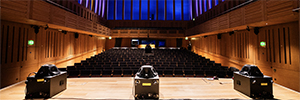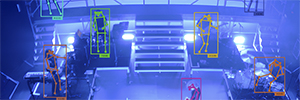The German band PUR bets on ArrayCalc for their concert at Veltins Arena
El concierto celebrado este año por la banda alemana PUR en el Veltins Arena de Alemania ha contado en su infraestructura de sonido con la Serie V de d&b, utilizando la función ArrayProcessing de ArrayCalc.
La banda de música alemana PUR ha vuelto a elegir el Veltins Arena, un estadio de fútbol cubierto en el que juega la Bundesliga el club Schalke 04 de Gelsenkirchen, para su concierto. En las cuatro veces que lo hizo anteriormente, utilizó un escenario circular, con público todo alrededor, y cada vez con un sistema PA diferente.
“Se trata de un espacio muy reverberante en el que se han utilizado muchos sistemas PA y diferentes configuraciones para superarlo. Y en esta ocasión hemos optado por la Serie V de d&b Audiotechnik, utilizando la función ArrayProcessing de ArrayCalc, con la que hemos logrado el mejor resultado que hayamos obtenido antes”, explica el técnico de sistemas Frank Müller.
 The V series of d&b es un arreglo en línea para estancias de tamaño medio, sin embargo decidieron utilizarlo en el estadio del Schalke. “Para los pabellones que tienen un aforo superior a 10.000 people, solíamos colgar delays. Por tanto, normalmente teníamos dieciséis V-TOP por lado para los clústers principales y ocho en la zona inferior de la sala para los delays. La Serie V es muy ligera y la carga que permite la estructura de rigging es de veinticuatro cajas (838 kilos incluida la estructura)”, comenta Müller.
The V series of d&b es un arreglo en línea para estancias de tamaño medio, sin embargo decidieron utilizarlo en el estadio del Schalke. “Para los pabellones que tienen un aforo superior a 10.000 people, solíamos colgar delays. Por tanto, normalmente teníamos dieciséis V-TOP por lado para los clústers principales y ocho en la zona inferior de la sala para los delays. La Serie V es muy ligera y la carga que permite la estructura de rigging es de veinticuatro cajas (838 kilos incluida la estructura)”, comenta Müller.
 “El balance tonal es uno de los aspectos que tuvimos en cuenta aquí. Para trabajar en una sala de este tamaño con distancias de proyección de hasta 105 metros sin ningún sistema de delay hay que contrarrestar las limitaciones de los sistemas de arreglo en línea. Por ejemplo los graves/medios de los sistemas tienden a ser fuertes en los primeros veinte metros y enturbian el balance tonal general. De manera parecida, la inteligibilidad se reduce con la distancia. Para d&b, el concierto en el estadio del Schalke era una gran oportunidad para experimentar en una configuración de escenario circular de 360° en un recinto de gran escala”, aclara Werner Vier Bayer, Product Manager of D&b.
“El balance tonal es uno de los aspectos que tuvimos en cuenta aquí. Para trabajar en una sala de este tamaño con distancias de proyección de hasta 105 metros sin ningún sistema de delay hay que contrarrestar las limitaciones de los sistemas de arreglo en línea. Por ejemplo los graves/medios de los sistemas tienden a ser fuertes en los primeros veinte metros y enturbian el balance tonal general. De manera parecida, la inteligibilidad se reduce con la distancia. Para d&b, el concierto en el estadio del Schalke era una gran oportunidad para experimentar en una configuración de escenario circular de 360° en un recinto de gran escala”, aclara Werner Vier Bayer, Product Manager of D&b.
Al examinar el área de escucha en ArrayCalc, se puede identificar la zona en la que la respuesta de frecuencia está balanceada y seleccionarla como la estrategia objetivo para todas las demás zonas. Next, mediante la función AP se calculan y se transfieren los ajustes personales de los filtros a cada canal concreto del amplificador, de manera que se puede aplicar la estrategia específica en toda el área de escucha completa.
 AP permite controlar todo el comportamiento del arreglo en las áreas de escucha dentro de su zona de direccionamiento mecánico determinada. “La ventaja de AP es que nos permite pulir los parámetros de espectro uniforme (respuesta de frecuencia) y los parámetros espaciales definidos (SPL con la distancia), además de los parámetros de refuerzo, que dan como resultado una directividad total superior que coincide con precisión con las zonas de público, así como una compensación de HFC continua y homogénea. Todo esto, sin perder la firma sónica de d&b ni comprometer el rango dinámico del sistema”, continúa Bayer.
AP permite controlar todo el comportamiento del arreglo en las áreas de escucha dentro de su zona de direccionamiento mecánico determinada. “La ventaja de AP es que nos permite pulir los parámetros de espectro uniforme (respuesta de frecuencia) y los parámetros espaciales definidos (SPL con la distancia), además de los parámetros de refuerzo, que dan como resultado una directividad total superior que coincide con precisión con las zonas de público, así como una compensación de HFC continua y homogénea. Todo esto, sin perder la firma sónica de d&b ni comprometer el rango dinámico del sistema”, continúa Bayer.
You liked this article?
Subscribe to our Feed And you won't miss a thing.















